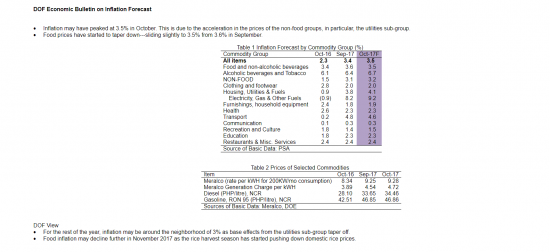The Department of Finance (DOF) said inflation in October 2017 likely peaked at 3.5 percent from 3.4 percent a month ago, driven mainly by higher price increases in non-food items, particularly utilities.
In an economic bulletin, DOF Undersecretary Gil Beltran said, however, that consumer prices would remain manageable on the expected palayharvest in the latter part of the year and as base effects from the utilities sub-group taper off.
“Food inflation may decline further in November 2017 as the rice harvest season has started pushing down domestic rice prices,” said Beltran, who is also the DOF’s chief economist.
Beltran also said that food prices have “started to taper down, sliding slightly to 3.5 percent from 3.6 percent in September.”
In its forecast by commodity group for the month of October, the DOF said alcoholic beverages and tobacco likely increased to 6.7 percent from 6.4 percent; housing, utilities and fuels to 4.1 percent from 3.8 percent; electricity, gas and other fuels to 9.2 percent from 8.2 percent; furnishings and household equipment to 1.9 percent from 1.8 percent; and recreation and culture to 1.5 percent from 1.4 percent.
Accompanying DOF data also showed that Meralco rate per kilowatt hour (kwh) for a household consuming 200 kilowatt per month increased to P9.28 from P9.25 in September. Also, Meralco generation charge per kwh in October increased to P4.72 from P4.54 in September 2017.
Inflation in September accelerated to a five-month high of 3.4 percent from 3.1 percent in August because of the higher annual increment in food and non-alcoholic beverages index at 5 percent and the double-digit increase in transport index at 11.3 percent.
This brought the average inflation in the first nine months to 3.1 percent, but still within the target range of 2 to 4 percent this year.
Last Sept. 21, 2017, the policy-making Monetary Board (MB), where Finance Secretary Carlos Dominguez III sits as a member, kept the benchmark interest rates mainly because of the manageable inflation environment and robust domestic economic growth.
The interest rates of 3.5 percent for overnight lending, 3 percent for overnight borrowing, and 2.5 percent for deposit facilities were maintained. The reserve requirement ratios were also maintained.
The MB also maintained the inflation average forecast this year and next at 3.2 percent. But the forecast for 2019 was adjusted upward to 3.2 percent from the earlier estimate of 3.1 percent.
The Duterte administration earlier projected sustained economic growth on the strength of higher fiscal expenditures, domestic demand and investments. .
Dominguez said earlier that the Gross Domestic Product (GDP) would likely grow faster in the second half as the government ramped up spending, particularly on its ambitious P8.44-trillion “Build, Build, Build” infra buildup program.




